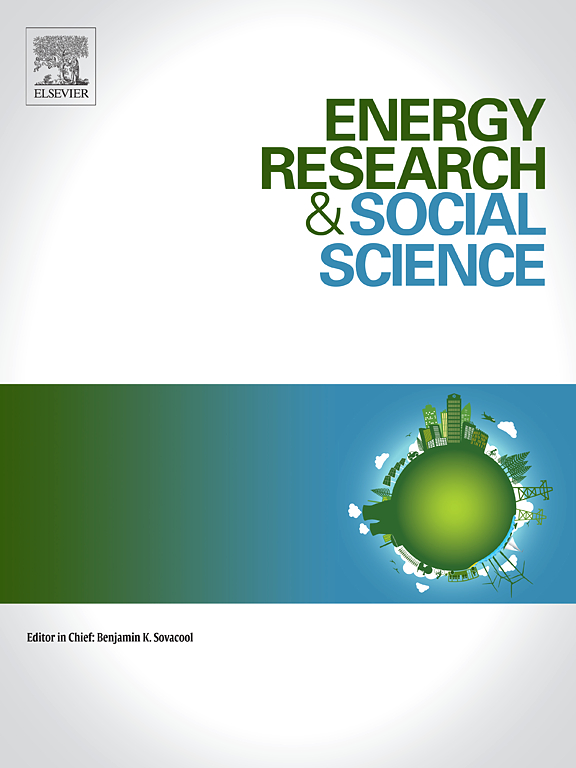解除地域差异:从采用者到公众推动灵活能源实践——挪威的案例
IF 7.4
2区 经济学
Q1 ENVIRONMENTAL STUDIES
引用次数: 0
摘要
灵活的能源管理解决方案已被证明可以增强能源供应安全和优化消费。尽管这些解决方案在技术上很有效,但用户接受度仍然是一个持续争论的话题。然而,对影响采用率因素的空间差异的研究仍处于起步阶段。这项研究扩大了来自挪威的个人层面的家庭调查数据,以调查影响家庭采用灵活能源使用的因素在城市层面、高度集中和不太集中的城市之间以及不同电价地区之间的差异。我们的研究结果揭示了几个关键的见解:首先,尽管电价存在巨大差异,但这些差异并不能显著解释灵活能源实践采用率的变化。其次,在高度集中和不那么集中的城市之间,采用的主要驱动因素存在很大差异。中心性指的是一个城市融入城市网络的程度,反映在基础设施、服务和人口密度上。在这两种情况下,财富仍然是一个重要因素。在高度集中的城市,多户住宅促进了灵活的能源使用,但在不太集中的地区,这种情况会受到阻碍。此外,居住年龄和电费随着集中化程度的不同而显著不同。为了扩大收养,缩小收养者和公众之间的态度、社会规范、自我效能、动机等心理变量的差距是至关重要的。这些见解强调了因地制宜的政策和应对具体挑战的重要性,以便有效地加强在非集中化城市采用灵活的能源解决方案。本文章由计算机程序翻译,如有差异,请以英文原文为准。
Unlocking geographic differences: from adopters to the public in driving the uptake of flexible energy practices—the case of Norway
Flexible energy management solutions have been proven to enhance energy supply security and optimise consumption. Despite their technical efficacy of these solutions, user acceptance remains a subject of ongoing debate. However, research into the spatial variation of the factors that influence adoption rates is still in its infancy. This study scaled up individual-level household survey data from Norway to investigate how the factors that influence household adoption of flexible energy use vary at the municipal level, between highly and less centralised municipalities, and between regions with different electricity prices. Our findings reveal several key insights: First, despite substantial differences in electricity prices, these differences do not significantly account for the variation in the adoption rate of flexible energy practices. Second, the primary drivers of adoption differ considerably between highly centralised and less centralised municipalities. Centrality here denotes a municipality's integration into urban networks, reflected by access to infrastructure, services, and population density. Wealth remains a significant factor in both contexts. Living in multi-family houses promotes flexible energy use in highly centralised municipalities, but hinders it in less centralised areas. In addition, dwelling age and electricity tariffs vary markedly with centralisation. Closing the gap in psychological variables, such as attitudes, social norms, self-efficacy, and motivation, between adopters and the public is crucial for expanding adoption. These insights emphasise the importance of context-specific policies and address specific challenges, in order to effectively enhance the adoption of flexible energy solutions in less centralised municipalities.
求助全文
通过发布文献求助,成功后即可免费获取论文全文。
去求助
来源期刊

Energy Research & Social Science
ENVIRONMENTAL STUDIES-
CiteScore
14.00
自引率
16.40%
发文量
441
审稿时长
55 days
期刊介绍:
Energy Research & Social Science (ERSS) is a peer-reviewed international journal that publishes original research and review articles examining the relationship between energy systems and society. ERSS covers a range of topics revolving around the intersection of energy technologies, fuels, and resources on one side and social processes and influences - including communities of energy users, people affected by energy production, social institutions, customs, traditions, behaviors, and policies - on the other. Put another way, ERSS investigates the social system surrounding energy technology and hardware. ERSS is relevant for energy practitioners, researchers interested in the social aspects of energy production or use, and policymakers.
Energy Research & Social Science (ERSS) provides an interdisciplinary forum to discuss how social and technical issues related to energy production and consumption interact. Energy production, distribution, and consumption all have both technical and human components, and the latter involves the human causes and consequences of energy-related activities and processes as well as social structures that shape how people interact with energy systems. Energy analysis, therefore, needs to look beyond the dimensions of technology and economics to include these social and human elements.
 求助内容:
求助内容: 应助结果提醒方式:
应助结果提醒方式:


